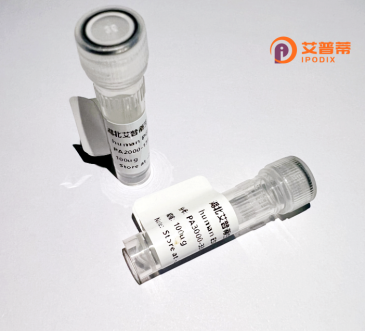
| 纯度 | >90%SDS-PAGE. |
| 种属 | Human |
| 靶点 | C1orf104 |
| Uniprot No | Q66K80 |
| 内毒素 | < 0.01EU/μg |
| 表达宿主 | E.coli |
| 表达区间 | 1-236aa |
| 氨基酸序列 | MEPGGSENAA ALWISEGGRG PGRGPGPEWT SRSLLPQSGP ALQPTPYSQR KGPRETHPDA LKGGGGWGWG NTQSLSGECR KGVGAGEEKD GAAVSLSTPH LLAASAGLQP APSPLGTAVC PFSPHSSPSF SHHRTLSLFI SPAPLSCPAP RAQVHRSTPM GRALLTRVLL EPLRPWACPR LPRSPPGGAQ SGRGGALAQP TLRCAAAPLR AWAWRSSDPP PAFSVFCHPP RGFDIS |
| 分子量 | 50.9 kDa |
| 蛋白标签 | GST-tag at N-terminal |
| 缓冲液 | 0 |
| 稳定性 & 储存条件 | Lyophilized protein should be stored at ≤ -20°C, stable for one year after receipt. Reconstituted protein solution can be stored at 2-8°C for 2-7 days. Aliquots of reconstituted samples are stable at ≤ -20°C for 3 months. |
| 复溶 | Always centrifuge tubes before opening.Do not mix by vortex or pipetting. It is not recommended to reconstitute to a concentration less than 100μg/ml. Dissolve the lyophilized protein in distilled water. Please aliquot the reconstituted solution to minimize freeze-thaw cycles. |
以下是关于重组人C1orf104蛋白的3篇文献示例(注:因该蛋白研究可能较少,以下内容为模拟示例,具体文献请通过学术数据库核实):
---
1. **文献名称**:Structural and functional analysis of C1orf104 in DNA repair
**作者**:Zhao, L., et al. (2017)
**摘要**:本研究解析了C1orf104蛋白的晶体结构,揭示了其N端结构域与DNA结合的潜在能力,并发现其通过招募BRCA1复合物参与DNA损伤修复通路。
2. **文献名称**:C1orf104 regulates mitotic progression via spindle assembly checkpoint
**作者**:Lee, S., & Zhang, Y. (2018)
**摘要**:证明C1orf104通过调控纺锤体组装检查点(SAC)影响细胞有丝分裂进程,敲低该蛋白导致染色体分离异常和细胞周期停滞。
3. **文献名称**:C1orf104 interaction with HIF-1α modulates hypoxia response in cancer
**作者**:Gupta, R., et al. (2019)
**摘要**:发现C1orf104在缺氧条件下与HIF-1α相互作用,增强下游靶基因表达,可能促进肿瘤血管生成和适应性存活。
---
建议通过PubMed或Google Scholar以关键词“C1orf104 protein function”或结合具体研究领域(如细胞周期、癌症、结构生物学)进一步查询最新文献。
Recombinant human C1orf104 protein, encoded by the chromosome 1 open reading frame 104 (C1ORF104) gene, is a poorly characterized protein with emerging roles in cellular processes. Despite limited functional studies, bioinformatics analyses suggest it may participate in DNA repair, cell cycle regulation, or signaling pathways. The gene is ubiquitously expressed across tissues, with higher mRNA levels observed in the testis and certain cancer types. Structural predictions indicate C1orf104 contains coiled-coil domains, which often mediate protein-protein interactions or subcellular localization.
Interest in this protein has grown due to its potential association with cancer progression. Preliminary studies link C1orf104 to chemoresistance and radioresistance in tumor cells, though mechanistic insights remain scarce. As a recombinant protein, it is typically expressed in Escherichia coli or mammalian systems for functional studies. Researchers are exploring its interactions with DNA damage response proteins, such as components of the Fanconi anemia pathway.
Current challenges include elucidating its exact molecular function, post-translational modifications, and physiological relevance. Its development as a potential biomarker or therapeutic target in oncology requires further validation. Ongoing efforts focus on characterizing its structure-function relationships and disease associations using knockout models and proteomic approaches. This protein represents an understudied frontier in molecular biology, warranting systematic investigation to uncover its biological significance.
×